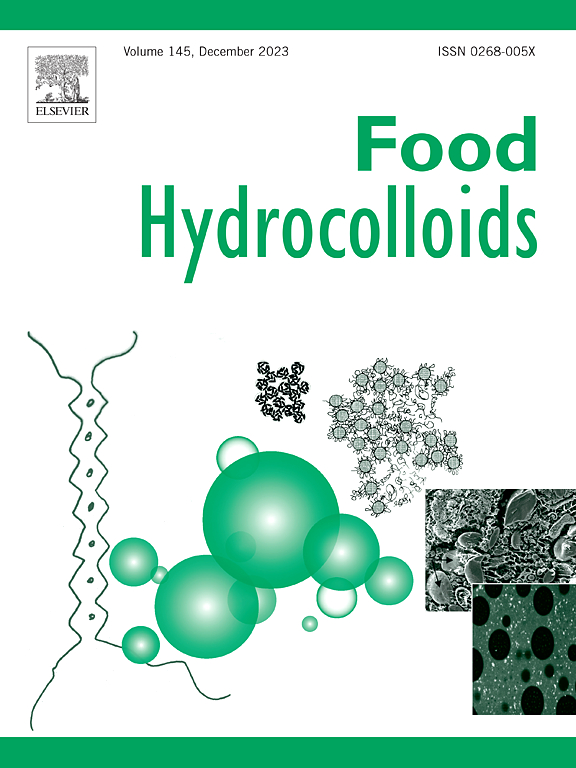Characterisation of an oat protein-beta-glucan co-extract
IF 11
1区 农林科学
Q1 CHEMISTRY, APPLIED
引用次数: 0
Abstract
We characterise a novel, dilute protein concentrate produced via alkaline extraction of defatted oat flour (DOF) without additional protein purification and identify a self-assembly of oat protein and dietary fibre (primarily oat β-glucan). The oat protein-β-glucan co-extract (OPBG) was characterised using sodium dodecyl-sulphate polyacrylamide gel electrophoresis (SDS-PAGE) and showed multiple protein bands, with major bands assigned to oat 12S globulin monomers (65–67 kDa) and its subunits (45 and 22 kDa). Circular dichroism (CD) spectroscopy revealed high quantities of β-sheet and random coil structures with evidence of partial protein unfolding at pH 2.0. The co-extract showed various degrees of aggregation when subjected to different pH (pH 2.0–10.0) and ionic strength (0–1.0 M added NaCl) conditions. At pH 2.0, β-glucan-β-glucan aggregates appeared dispersed in a continuous protein phase. At pH 7.0, OPBG displayed a compact aggregated microstructure with a hydrodynamic diameter (dH) of ∼100–150 nm and a polydispersity index of 0.28, where binary protein-β-glucan clusters co-existed with singular entities, i.e. protein-protein and β-glucan-β-glucan aggregates. Complementary ζ-potential measurements confirmed a negative surface charge at pH 7.0 and isoelectric point (pI) of 4.0–4.5. As the pH increased to 10.0, confocal laser scanning microscopy (CLSM) images revealed strong colocalisation of the protein and β-glucan, with consequent evolution of a smaller peak (dH ∼ 20 nm) resembling oat 12S globulin hexamers. Overall, hydrogen bonding appeared to dominate the protein-polysaccharide interactions in OPBG, whilst its colloidal properties, including responsiveness to pH and added salt, seemed to be largely governed by the proteinaceous fraction.

燕麦蛋白-葡聚糖共萃取物的表征
我们描述了一种新型的稀释蛋白浓缩物,通过碱性提取脱脂燕麦粉(DOF)而无需额外的蛋白质纯化,并鉴定了燕麦蛋白和膳食纤维(主要是燕麦β-葡聚糖)的自组装。利用十二烷基硫酸钠聚丙烯酰胺凝胶电泳(SDS-PAGE)对燕麦蛋白-β-葡聚糖共提取物(OPBG)进行了表征,结果显示出多个蛋白条带,其中主要条带分配给燕麦12S球蛋白单体(65-67 kDa)及其亚基(45和22 kDa)。圆二色(CD)光谱显示了大量的β-片和随机线圈结构,并证明了部分蛋白质在pH 2.0下展开。在不同pH值(pH 2.0 ~ 10.0)和离子强度(NaCl添加量0 ~ 1.0 M)条件下,共提物呈现出不同程度的聚集。在pH为2.0时,β-葡聚糖-β-葡聚糖聚集体分散在连续的蛋白相中。在pH 7.0时,OPBG呈现致密聚集的微观结构,水动力直径(dH)为~ 100-150 nm,多分散性指数为0.28,其中二元蛋白质-β-葡聚糖团簇与单一实体共存,即蛋白质-蛋白质和β-葡聚糖-β-葡聚糖聚集体。互补的ζ-电位测量证实了在pH 7.0和等电点(pI)为4.0-4.5时的负表面电荷。当pH增加到10.0时,共聚焦激光扫描显微镜(CLSM)图像显示蛋白质和β-葡聚糖强烈共定位,随后进化出一个较小的峰(dH ~ 20 nm),类似于燕麦12S球蛋白六聚体。总的来说,在OPBG中,氢键似乎主导了蛋白质-多糖的相互作用,而它的胶体性质,包括对pH值和添加盐的响应性,似乎在很大程度上受蛋白质部分的控制。
本文章由计算机程序翻译,如有差异,请以英文原文为准。
求助全文
约1分钟内获得全文
求助全文
来源期刊

Food Hydrocolloids
工程技术-食品科技
CiteScore
19.90
自引率
14.00%
发文量
871
审稿时长
37 days
期刊介绍:
Food Hydrocolloids publishes original and innovative research focused on the characterization, functional properties, and applications of hydrocolloid materials used in food products. These hydrocolloids, defined as polysaccharides and proteins of commercial importance, are added to control aspects such as texture, stability, rheology, and sensory properties. The research's primary emphasis should be on the hydrocolloids themselves, with thorough descriptions of their source, nature, and physicochemical characteristics. Manuscripts are expected to clearly outline specific aims and objectives, include a fundamental discussion of research findings at the molecular level, and address the significance of the results. Studies on hydrocolloids in complex formulations should concentrate on their overall properties and mechanisms of action, while simple formulation development studies may not be considered for publication.
The main areas of interest are:
-Chemical and physicochemical characterisation
Thermal properties including glass transitions and conformational changes-
Rheological properties including viscosity, viscoelastic properties and gelation behaviour-
The influence on organoleptic properties-
Interfacial properties including stabilisation of dispersions, emulsions and foams-
Film forming properties with application to edible films and active packaging-
Encapsulation and controlled release of active compounds-
The influence on health including their role as dietary fibre-
Manipulation of hydrocolloid structure and functionality through chemical, biochemical and physical processes-
New hydrocolloids and hydrocolloid sources of commercial potential.
The Journal also publishes Review articles that provide an overview of the latest developments in topics of specific interest to researchers in this field of activity.
 求助内容:
求助内容: 应助结果提醒方式:
应助结果提醒方式:


